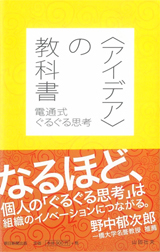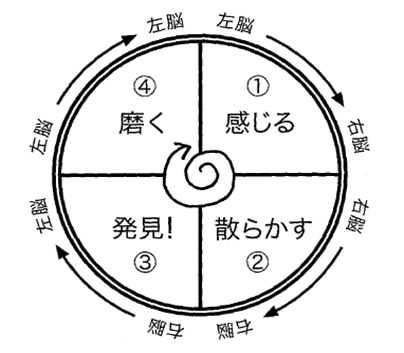This month, the 11th is Mother's Day. As I've written before, my mother, born in 1934, was global in outlook, unlike her son. She attended kindergarten in Geneva, Switzerland, and often reminisced about things like, "I'll never forget the polenta I ate back then." Polenta, an Italian dish made by boiling coarse cornmeal, is something I've only started seeing occasionally again recently. My mother cooks it in chicken broth, then browns it, serving it as a side dish with meat.

Now then. The methodology for creating concepts (ideas) called "Circular Thinking," which I introduced in my book The Textbook of Ideas, synthesizes a unique thought process passed down in advertising agencies. However, when modeling it, the foundation was based on advertising agency experience and insights from management studies. So this time, let's call it "Circular Thinking's Mother" and discuss the methodology for generating ideas in advertising.
James W. Young, who once served as president of the American Advertising Agencies Association, wrote the global bestseller "How to Think Up Ideas" (1940). This book introduces "the entire process or method by which ideas are created."
First: Gathering Data—This involves constantly enriching your store of materials and general knowledge relevant to your immediate task.
Second: Processing Data in Your Mind.
Third: The Incubation Stage. Here, you allow something to do the work of combining elements for you, outside your conscious awareness.
Fourth: The actual birth of the idea. The "Eureka! I've got it! I've found it!" stage. And
Fifth: The stage of finally concretizing and developing the idea to match its practical usefulness.
Young himself cites this as literature "for deepening understanding," but its foundation is the "four-stage theory" introduced by British sociologist Graham Wallas in The Art of Thought (1926): "① Preparation → ② Incubation → ③ Illumination → ④ Verification." This remains a standard approach in the advertising industry nearly a century later.

The four modes of Swirling Thinking—"① Feel → Scatter → ③ Eureka! → ④ Polish"—correspond to each stage of the Four-Stage Theory, aiming to explain its practical application in greater detail.
For example, Young presents the moment of acquiring an idea (③ Eureka!) as a sudden, mystical experience, whereas Swirling Thinking views its essence as "organization." (See: Session 17 ) Another distinctive feature of Swirling Thinking is its assertion that "the challenge is discovered simultaneously with the idea."
Regarding the materials for ideas: Young, based on a Western view of knowledge, uses the terms "knowledge" and "materials" almost synonymously. In contrast, the "Guruguru Thinking" approach considers even "embodied knowledge" – such as a craftsman's skills, experience, and intuition that cannot be verbalized (≈ documented) – as valuable material for ideas. (See: Session 11/13 )
While there are some differences, the fundamental framework of combining existing knowledge to create new perspectives remains the same. Spiral Thinking was born into this world with the Four-Stage Theory as its mother.
 |
My polenta. Something's off...
|
My mother, who was energetic enough to walk around the Imperial Palace this New Year's, collapsed from a subarachnoid hemorrhage in late January. Things like this happen suddenly, don't they? After four surgeries, we've finally seen some bright signs recently. Somehow, the polenta I make just isn't quite right. Get well soon and show us the skills of a Showa-era repatriate.
Next time: "The Spinning Father."
Enjoy your meal!





